Cuisine of Nung Chao ethnic at Hoang Viet commune, Van Lang district, Lang Son province
Nung Chao is a Nung ethnic group in Vietnam originating, they has lived to Lang Son province (Vietnam) for a long
time. In the course of history, cultural exchange with local people
in Lang Son province, at same time, inheriting the culture of the
Guangxi region (China), the Nung Chao people have drawn up the
cultural characteristics of extremely identity richness, especially
cuisine culture. The cuisine of the Nung Chao is extremely diverse
with a mixture of Kinh, Tay and Chinese cuisine and cultural
institutions related to cuisine to be a valuable heritage not only of
Lang Son province but also of the Vietnamese ethnic community.
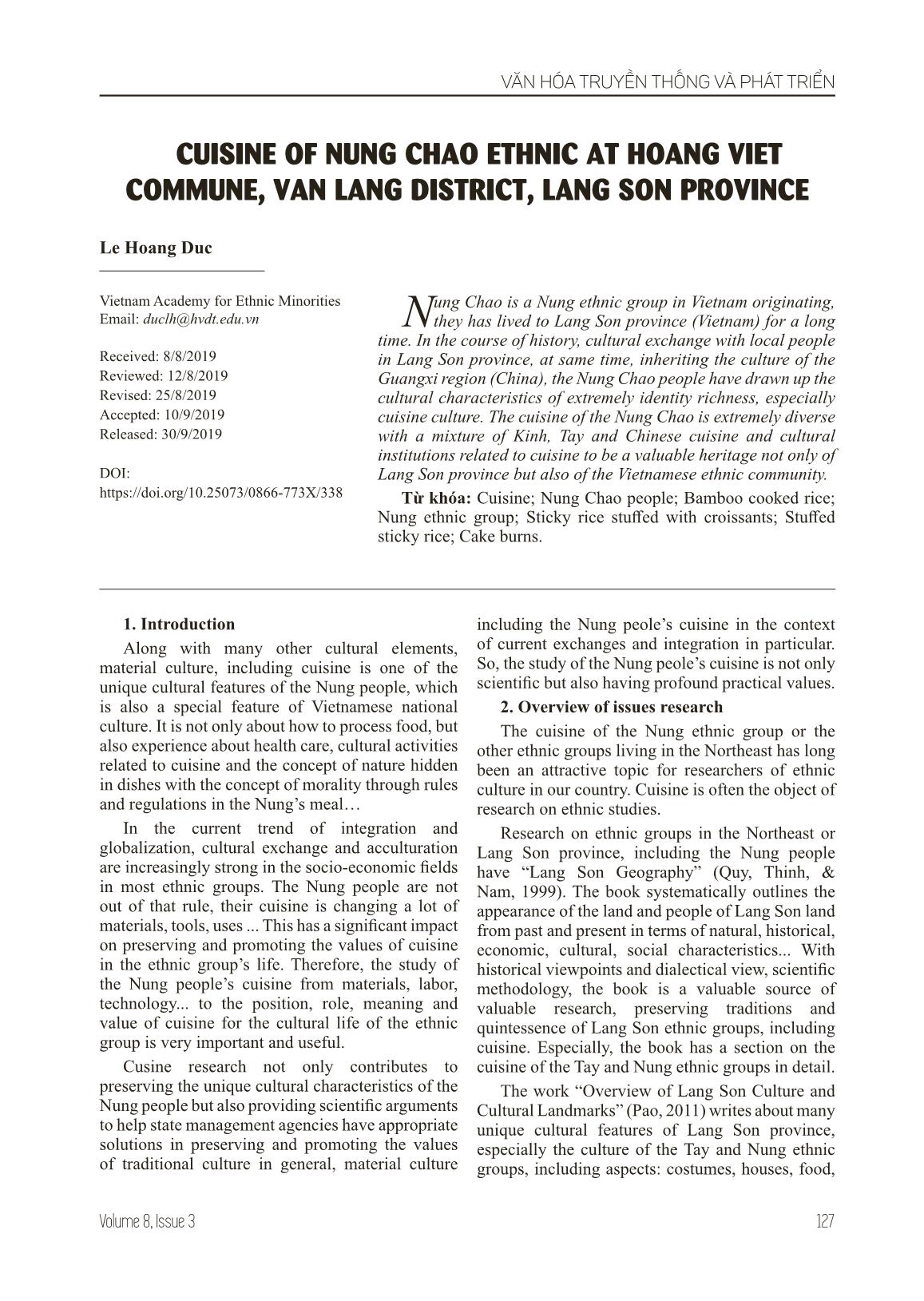
Trang 1
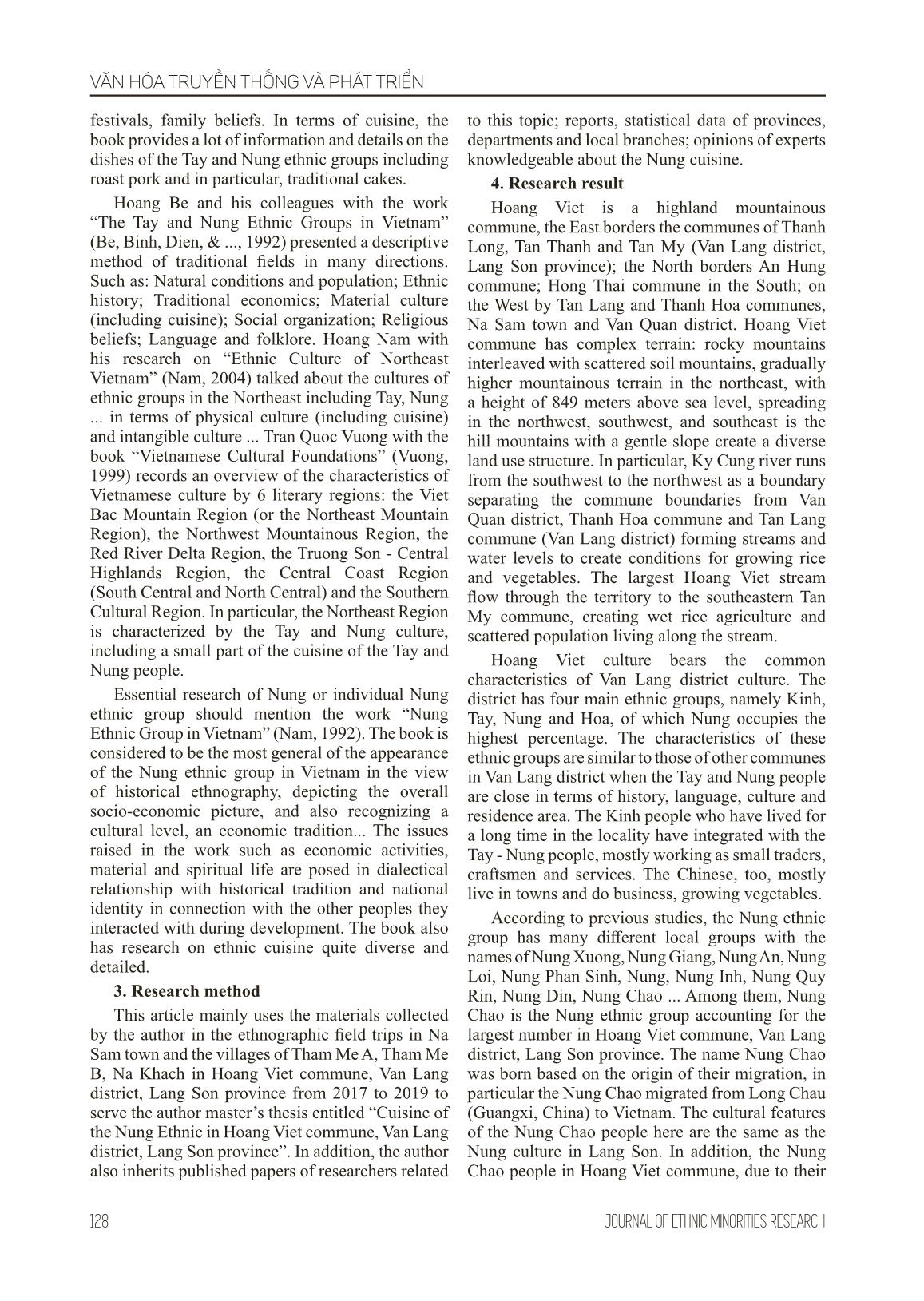
Trang 2
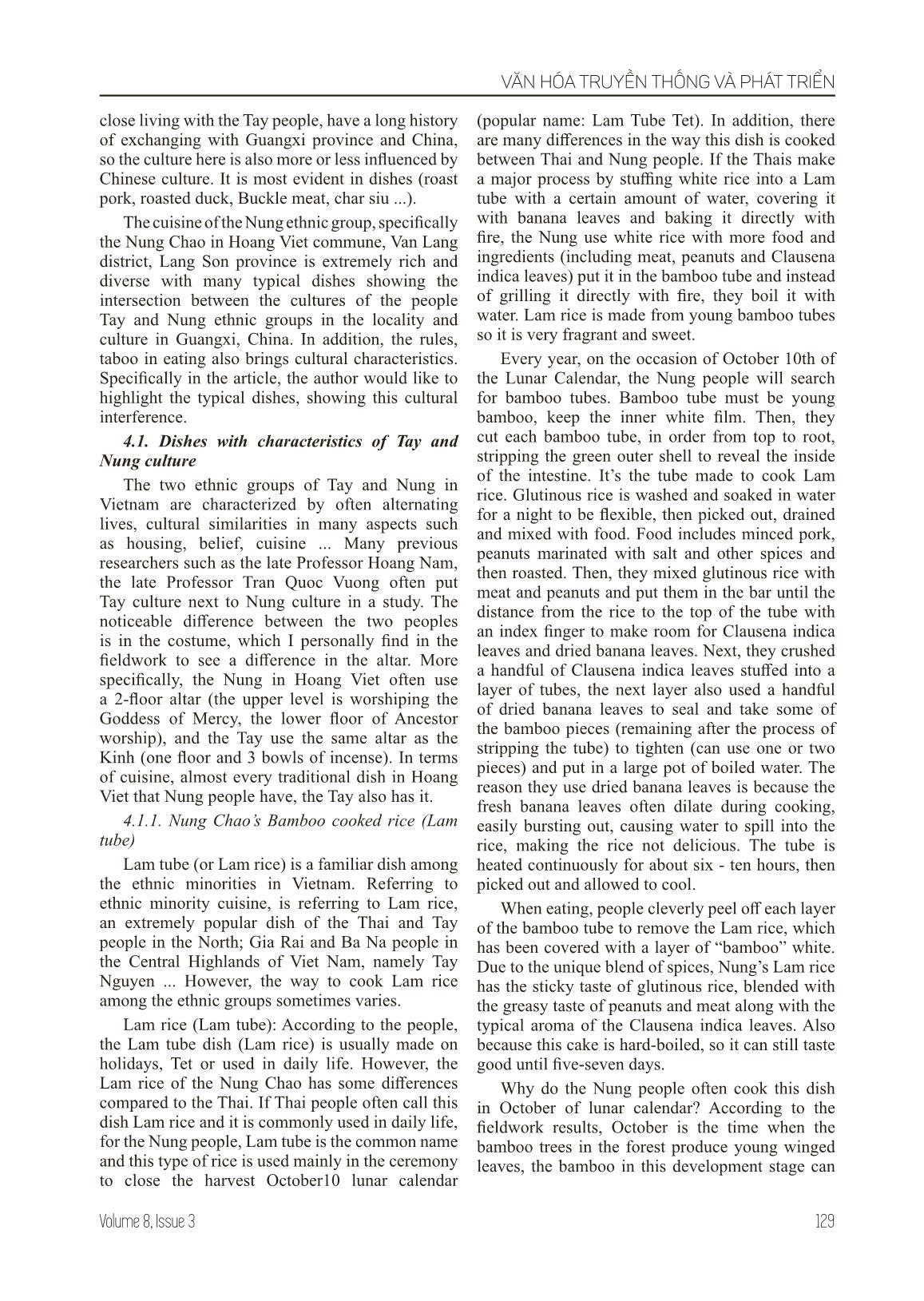
Trang 3
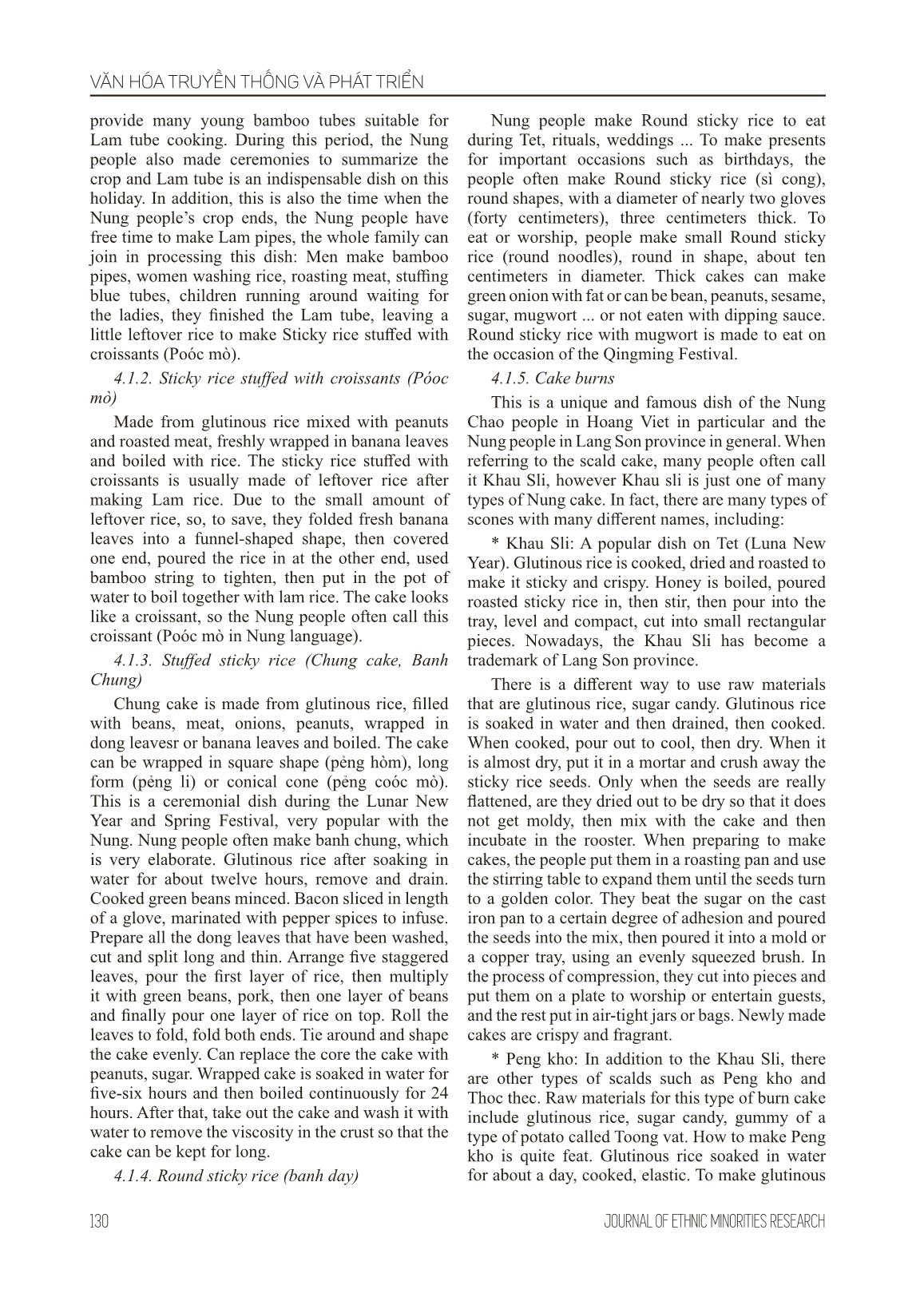
Trang 4
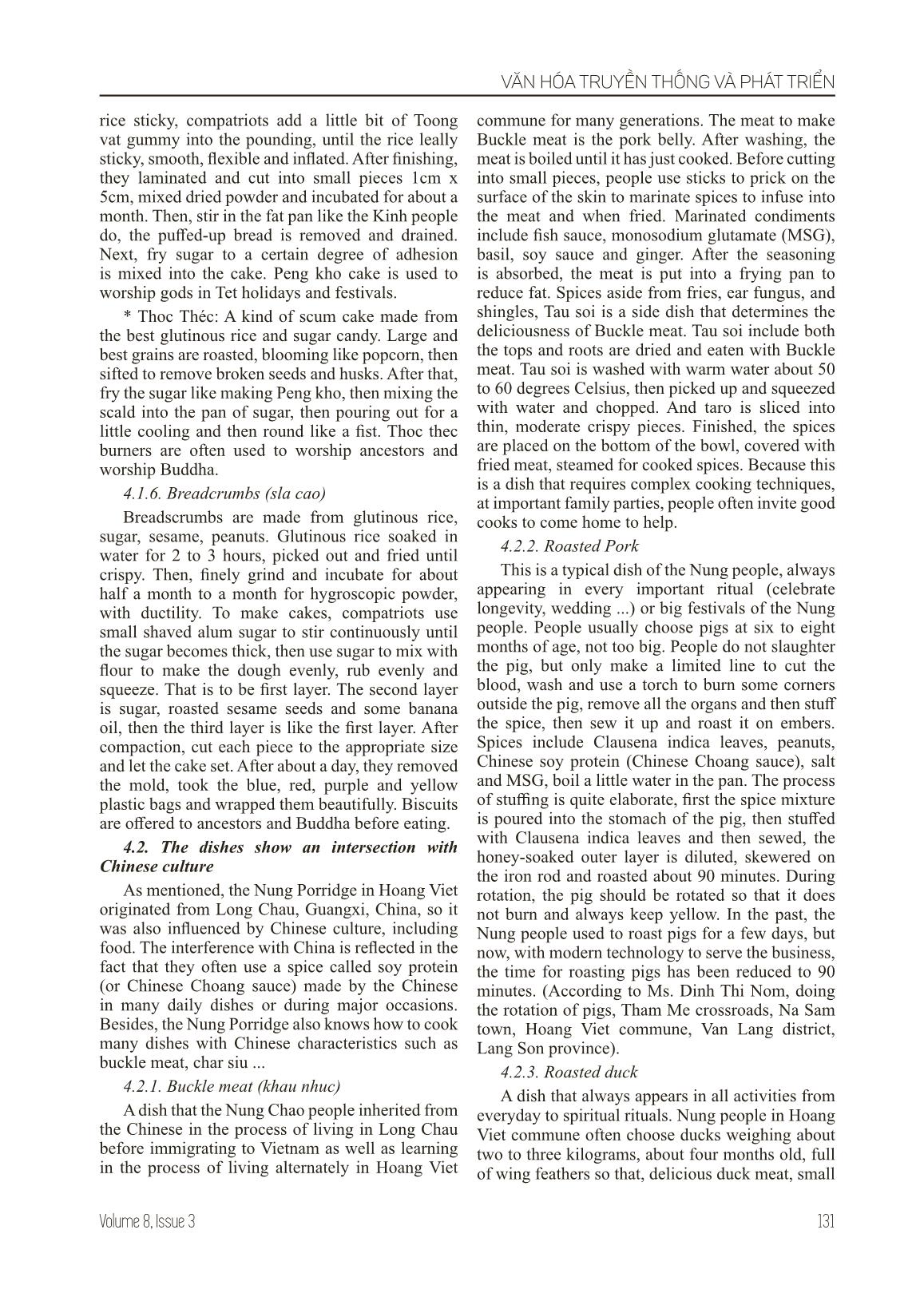
Trang 5
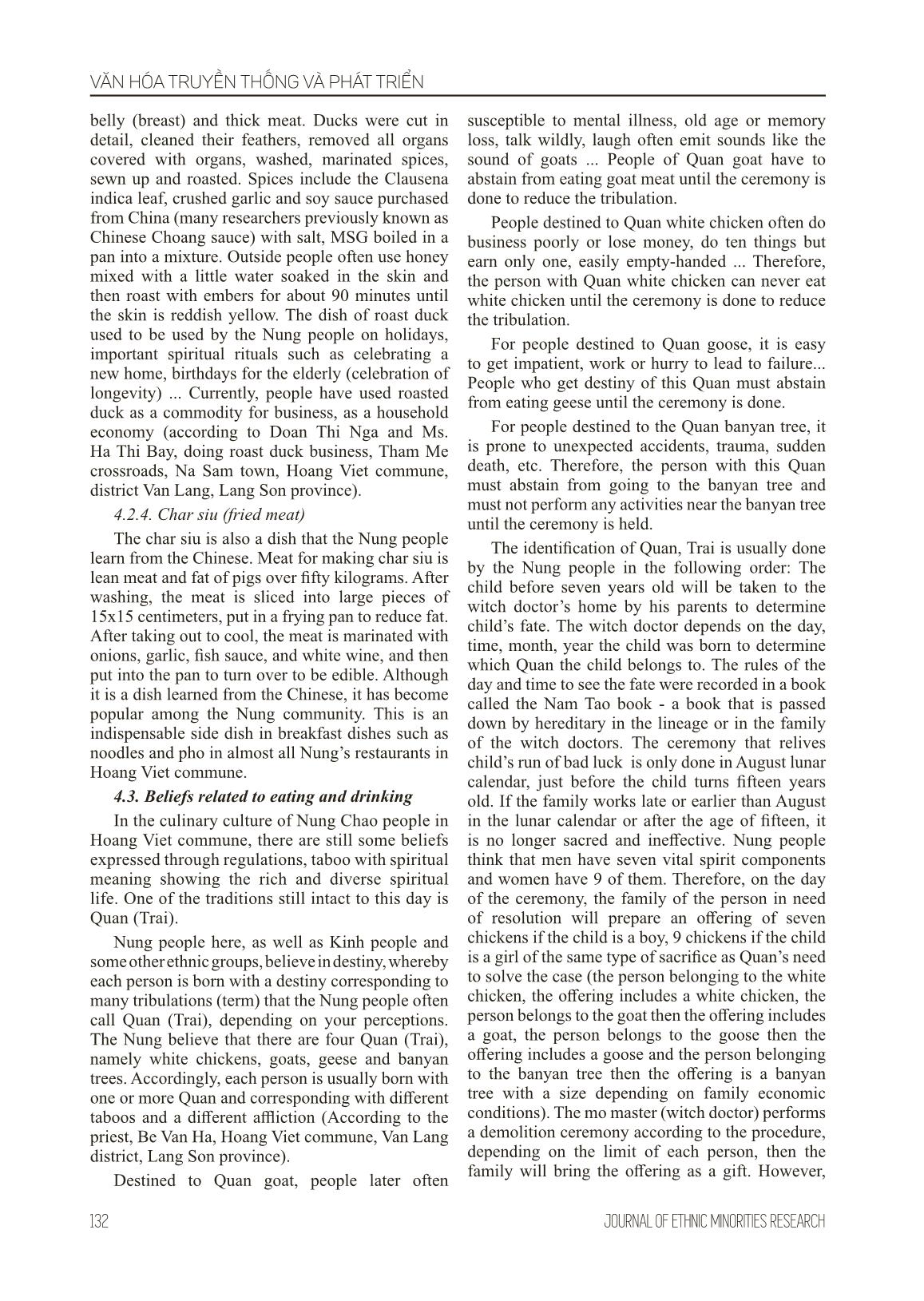
Trang 6
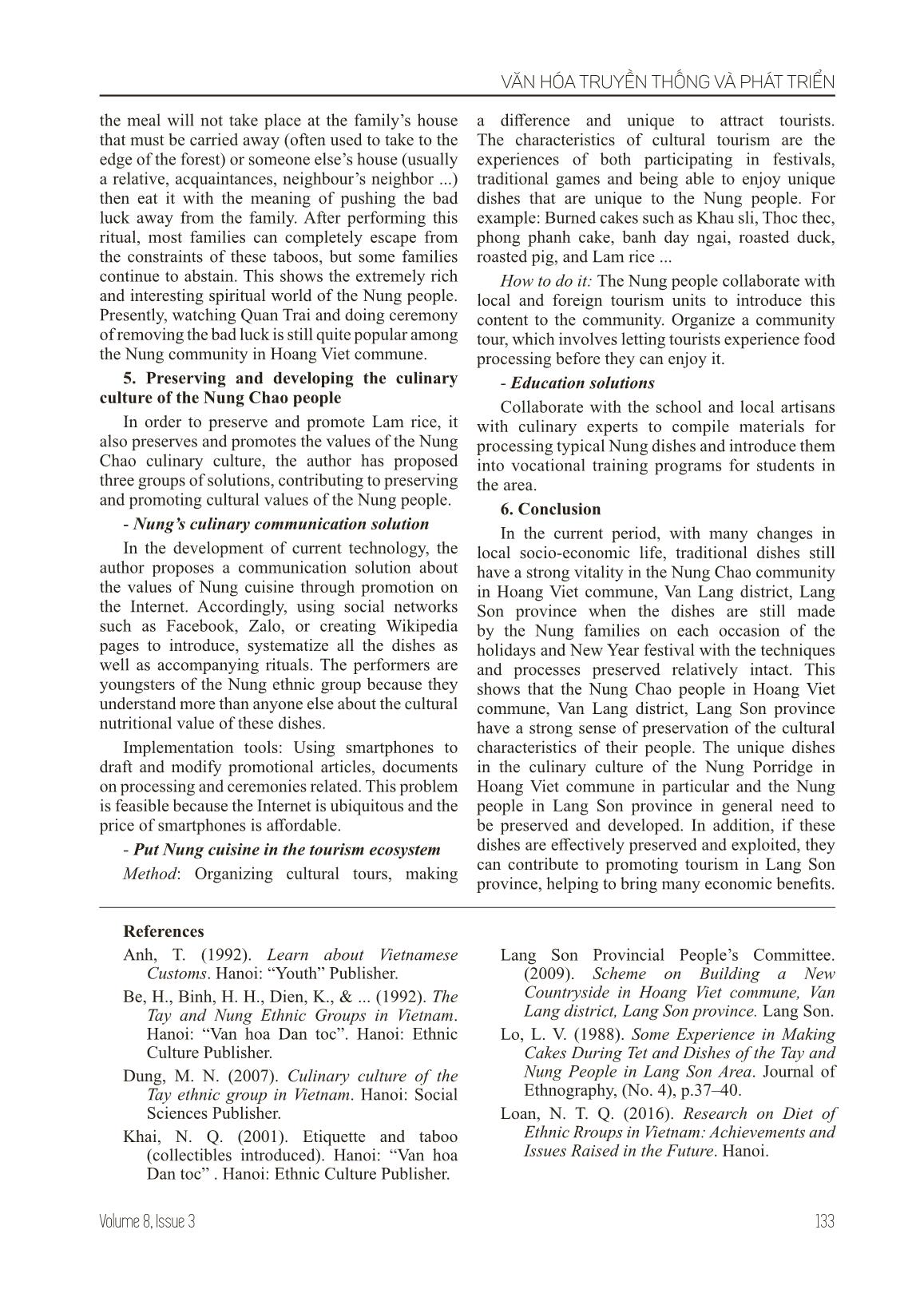
Trang 7
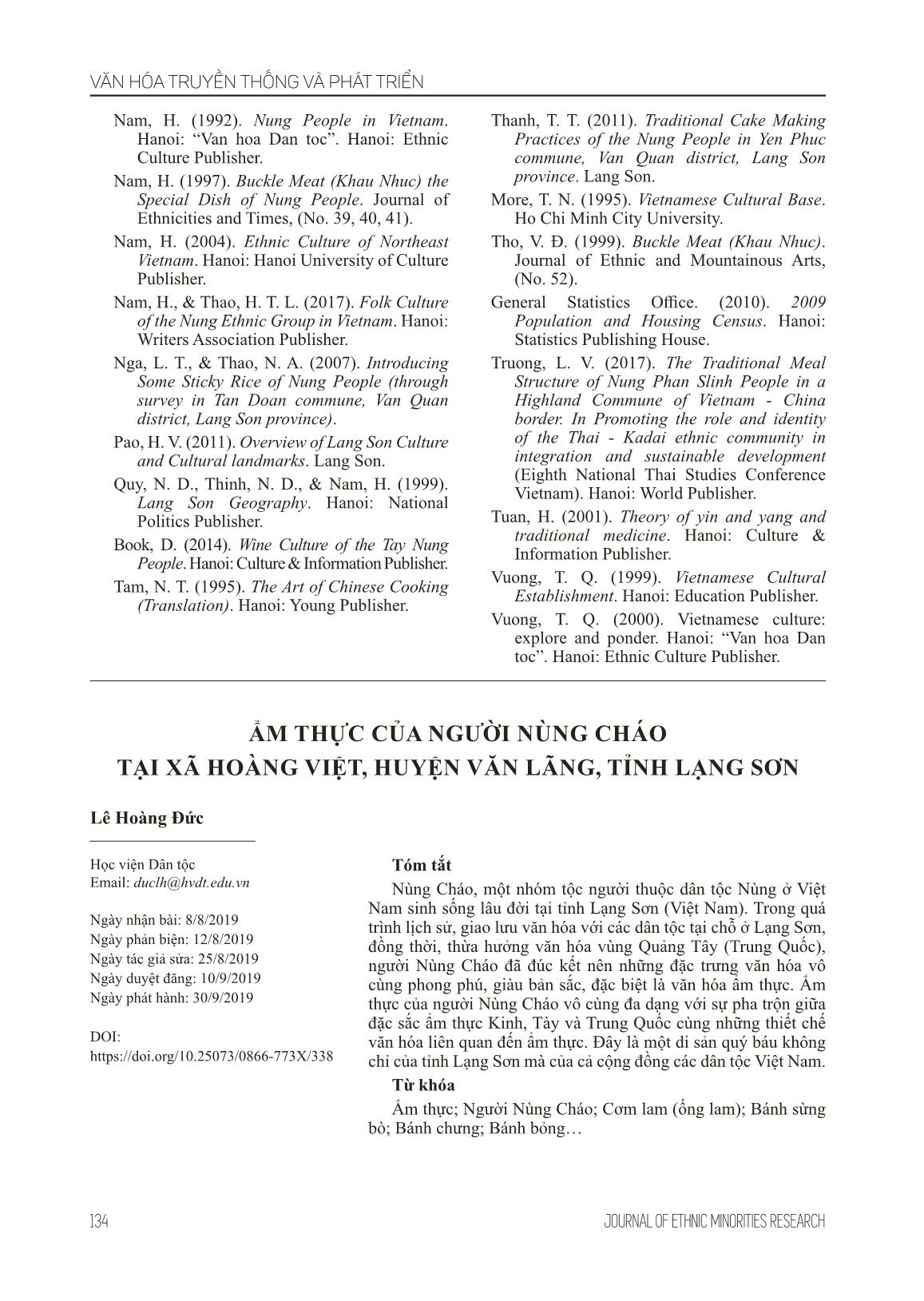
Trang 8
Bạn đang xem tài liệu "Cuisine of Nung Chao ethnic at Hoang Viet commune, Van Lang district, Lang Son province", để tải tài liệu gốc về máy hãy click vào nút Download ở trên
Tóm tắt nội dung tài liệu: Cuisine of Nung Chao ethnic at Hoang Viet commune, Van Lang district, Lang Son province
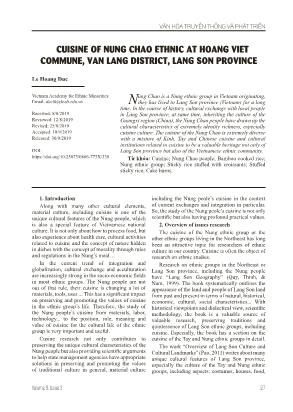
VĂN HÓA TRUYỀN THỐNG VÀ PHÁT TRIỂN 127Volume 8, Issue 3 CUISINE OF NUNG CHAO ETHNIC AT HOANG VIET COMMUNE, VAN LANG DISTRICT, LANG SON PROVINCE Le Hoang Duc Vietnam Academy for Ethnic Minorities Email: duclh@hvdt.edu.vn Received: 8/8/2019 Reviewed: 12/8/2019 Revised: 25/8/2019 Accepted: 10/9/2019 Released: 30/9/2019 DOI: https://doi.org/10.25073/0866-773X/338 Nung Chao is a Nung ethnic group in Vietnam originating, they has lived to Lang Son province (Vietnam) for a long time. In the course of history, cultural exchange with local people in Lang Son province, at same time, inheriting the culture of the Guangxi region (China), the Nung Chao people have drawn up the cultural characteristics of extremely identity richness, especially cuisine culture. The cuisine of the Nung Chao is extremely diverse with a mixture of Kinh, Tay and Chinese cuisine and cultural institutions related to cuisine to be a valuable heritage not only of Lang Son province but also of the Vietnamese ethnic community. Từ khóa: Cuisine; Nung Chao people; Bamboo cooked rice; Nung ethnic group; Sticky rice stuffed with croissants; Stuffed sticky rice; Cake burns. 1. Introduction Along with many other cultural elements, material culture, including cuisine is one of the unique cultural features of the Nung people, which is also a special feature of Vietnamese national culture. It is not only about how to process food, but also experience about health care, cultural activities related to cuisine and the concept of nature hidden in dishes with the concept of morality through rules and regulations in the Nung’s meal In the current trend of integration and globalization, cultural exchange and acculturation are increasingly strong in the socio-economic fields in most ethnic groups. The Nung people are not out of that rule, their cuisine is changing a lot of materials, tools, uses ... This has a significant impact on preserving and promoting the values of cuisine in the ethnic group’s life. Therefore, the study of the Nung people’s cuisine from materials, labor, technology... to the position, role, meaning and value of cuisine for the cultural life of the ethnic group is very important and useful. Cusine research not only contributes to preserving the unique cultural characteristics of the Nung people but also providing scientific arguments to help state management agencies have appropriate solutions in preserving and promoting the values of traditional culture in general, material culture including the Nung peole’s cuisine in the context of current exchanges and integration in particular. So, the study of the Nung peole’s cuisine is not only scientific but also having profound practical values. 2. Overview of issues research The cuisine of the Nung ethnic group or the other ethnic groups living in the Northeast has long been an attractive topic for researchers of ethnic culture in our country. Cuisine is often the object of research on ethnic studies. Research on ethnic groups in the Northeast or Lang Son province, including the Nung people have “Lang Son Geography” (Quy, Thinh, & Nam, 1999). The book systematically outlines the appearance of the land and people of Lang Son land from past and present in terms of natural, historical, economic, cultural, social characteristics... With historical viewpoints and dialectical view, scientific methodology, the book is a valuable source of valuable research, preserving traditions and quintessence of Lang Son ethnic groups, including cuisine. Especially, the book has a section on the cuisine of the Tay and Nung ethnic groups in detail. The work “Overview of Lang Son Culture and Cultural Landmarks” (Pao, 2011) writes about many unique cultural features of Lang Son province, especially the culture of the Tay and Nung ethnic groups, including aspects: costumes, houses, food, VĂN HÓA TRUYỀN THỐNG VÀ PHÁT TRIỂN 128 JOURNAL OF ETHNIC MINORITIES RESEARCH festivals, family beliefs. In terms of cuisine, the book provides a lot of information and details on the dishes of the Tay and Nung ethnic groups including roast pork and in particular, traditional cakes. Hoang Be and his colleagues with the work “The Tay and Nung Ethnic Groups in Vietnam” (Be, Binh, Dien, & ..., 1992) presented a descriptive method of traditional fields in many directions. Such as: Natural conditions and population; Ethnic history; Traditional economics; Material culture (including cuisine); Social organization; Religious beliefs; Language and folklore. Hoang Nam with his research on “Ethnic Culture of Northeast Vietnam” (Nam, 2004) talked about the cultures of ethnic groups in the Northeast including Tay, Nung ... in terms of physical culture (including cuisine) and intangible culture ... Tran Quoc Vuong with the book “Vietnamese Cultural Foundations” (Vuong, 1999) records an overview of the characteristics of Vietnamese culture by 6 literary regions: the Viet Bac Mountain Region (or the Northeast Mountain Region), the Northwest Mountainous Region, the Red River Delta Region, the Truong Son - Central Highlands Region, the Central Coast Region (South Central and North Central) and the Southern Cultural Region. In particular, the Northeast Region is characterized by the Tay and Nung culture, including a small part of the cuisine of the Tay and Nung people. Essential research of Nung or individual Nung ethnic group should mention the work “Nung Ethnic Group in Vietnam” (Nam, 1992). The book is considered to be the most general of the appearance of the Nung ethnic group in Vietnam in the view of historical ethnography, depicting the overall socio-economic picture, and also recognizing a cultural level, an economic tradition... The issues raised in the work such as economic activities, material and spiritual life ar ... now, with modern technology to serve the business, the time for roasting pigs has been reduced to 90 minutes. (According to Ms. Dinh Thi Nom, doing the rotation of pigs, Tham Me crossroads, Na Sam town, Hoang Viet commune, Van Lang district, Lang Son province). 4.2.3. Roasted duck A dish that always appears in all activities from everyday to spiritual rituals. Nung people in Hoang Viet commune often choose ducks weighing about two to three kilograms, about four months old, full of wing feathers so that, delicious duck meat, small VĂN HÓA TRUYỀN THỐNG VÀ PHÁT TRIỂN 132 JOURNAL OF ETHNIC MINORITIES RESEARCH belly (breast) and thick meat. Ducks were cut in detail, cleaned their feathers, removed all organs covered with organs, washed, marinated spices, sewn up and roasted. Spices include the Clausena indica leaf, crushed garlic and soy sauce purchased from China (many researchers previously known as Chinese Choang sauce) with salt, MSG boiled in a pan into a mixture. Outside people often use honey mixed with a little water soaked in the skin and then roast with embers for about 90 minutes until the skin is reddish yellow. The dish of roast duck used to be used by the Nung people on holidays, important spiritual rituals such as celebrating a new home, birthdays for the elderly (celebration of longevity) ... Currently, people have used roasted duck as a commodity for business, as a household economy (according to Doan Thi Nga and Ms. Ha Thi Bay, doing roast duck business, Tham Me crossroads, Na Sam town, Hoang Viet commune, district Van Lang, Lang Son province). 4.2.4. Char siu (fried meat) The char siu is also a dish that the Nung people learn from the Chinese. Meat for making char siu is lean meat and fat of pigs over fifty kilograms. After washing, the meat is sliced into large pieces of 15x15 centimeters, put in a frying pan to reduce fat. After taking out to cool, the meat is marinated with onions, garlic, fish sauce, and white wine, and then put into the pan to turn over to be edible. Although it is a dish learned from the Chinese, it has become popular among the Nung community. This is an indispensable side dish in breakfast dishes such as noodles and pho in almost all Nung’s restaurants in Hoang Viet commune. 4.3. Beliefs related to eating and drinking In the culinary culture of Nung Chao people in Hoang Viet commune, there are still some beliefs expressed through regulations, taboo with spiritual meaning showing the rich and diverse spiritual life. One of the traditions still intact to this day is Quan (Trai). Nung people here, as well as Kinh people and some other ethnic groups, believe in destiny, whereby each person is born with a destiny corresponding to many tribulations (term) that the Nung people often call Quan (Trai), depending on your perceptions. The Nung believe that there are four Quan (Trai), namely white chickens, goats, geese and banyan trees. Accordingly, each person is usually born with one or more Quan and corresponding with different taboos and a different affliction (According to the priest, Be Van Ha, Hoang Viet commune, Van Lang district, Lang Son province). Destined to Quan goat, people later often susceptible to mental illness, old age or memory loss, talk wildly, laugh often emit sounds like the sound of goats ... People of Quan goat have to abstain from eating goat meat until the ceremony is done to reduce the tribulation. People destined to Quan white chicken often do business poorly or lose money, do ten things but earn only one, easily empty-handed ... Therefore, the person with Quan white chicken can never eat white chicken until the ceremony is done to reduce the tribulation. For people destined to Quan goose, it is easy to get impatient, work or hurry to lead to failure... People who get destiny of this Quan must abstain from eating geese until the ceremony is done. For people destined to the Quan banyan tree, it is prone to unexpected accidents, trauma, sudden death, etc. Therefore, the person with this Quan must abstain from going to the banyan tree and must not perform any activities near the banyan tree until the ceremony is held. The identification of Quan, Trai is usually done by the Nung people in the following order: The child before seven years old will be taken to the witch doctor’s home by his parents to determine child’s fate. The witch doctor depends on the day, time, month, year the child was born to determine which Quan the child belongs to. The rules of the day and time to see the fate were recorded in a book called the Nam Tao book - a book that is passed down by hereditary in the lineage or in the family of the witch doctors. The ceremony that relives child’s run of bad luck is only done in August lunar calendar, just before the child turns fifteen years old. If the family works late or earlier than August in the lunar calendar or after the age of fifteen, it is no longer sacred and ineffective. Nung people think that men have seven vital spirit components and women have 9 of them. Therefore, on the day of the ceremony, the family of the person in need of resolution will prepare an offering of seven chickens if the child is a boy, 9 chickens if the child is a girl of the same type of sacrifice as Quan’s need to solve the case (the person belonging to the white chicken, the offering includes a white chicken, the person belongs to the goat then the offering includes a goat, the person belongs to the goose then the offering includes a goose and the person belonging to the banyan tree then the offering is a banyan tree with a size depending on family economic conditions). The mo master (witch doctor) performs a demolition ceremony according to the procedure, depending on the limit of each person, then the family will bring the offering as a gift. However, VĂN HÓA TRUYỀN THỐNG VÀ PHÁT TRIỂN 133Volume 8, Issue 3 the meal will not take place at the family’s house that must be carried away (often used to take to the edge of the forest) or someone else’s house (usually a relative, acquaintances, neighbour’s neighbor ...) then eat it with the meaning of pushing the bad luck away from the family. After performing this ritual, most families can completely escape from the constraints of these taboos, but some families continue to abstain. This shows the extremely rich and interesting spiritual world of the Nung people. Presently, watching Quan Trai and doing ceremony of removing the bad luck is still quite popular among the Nung community in Hoang Viet commune. 5. Preserving and developing the culinary culture of the Nung Chao people In order to preserve and promote Lam rice, it also preserves and promotes the values of the Nung Chao culinary culture, the author has proposed three groups of solutions, contributing to preserving and promoting cultural values of the Nung people. - Nung’s culinary communication solution In the development of current technology, the author proposes a communication solution about the values of Nung cuisine through promotion on the Internet. Accordingly, using social networks such as Facebook, Zalo, or creating Wikipedia pages to introduce, systematize all the dishes as well as accompanying rituals. The performers are youngsters of the Nung ethnic group because they understand more than anyone else about the cultural nutritional value of these dishes. Implementation tools: Using smartphones to draft and modify promotional articles, documents on processing and ceremonies related. This problem is feasible because the Internet is ubiquitous and the price of smartphones is affordable. - Put Nung cuisine in the tourism ecosystem Method: Organizing cultural tours, making a difference and unique to attract tourists. The characteristics of cultural tourism are the experiences of both participating in festivals, traditional games and being able to enjoy unique dishes that are unique to the Nung people. For example: Burned cakes such as Khau sli, Thoc thec, phong phanh cake, banh day ngai, roasted duck, roasted pig, and Lam rice ... How to do it: The Nung people collaborate with local and foreign tourism units to introduce this content to the community. Organize a community tour, which involves letting tourists experience food processing before they can enjoy it. - Education solutions Collaborate with the school and local artisans with culinary experts to compile materials for processing typical Nung dishes and introduce them into vocational training programs for students in the area. 6. Conclusion In the current period, with many changes in local socio-economic life, traditional dishes still have a strong vitality in the Nung Chao community in Hoang Viet commune, Van Lang district, Lang Son province when the dishes are still made by the Nung families on each occasion of the holidays and New Year festival with the techniques and processes preserved relatively intact. This shows that the Nung Chao people in Hoang Viet commune, Van Lang district, Lang Son province have a strong sense of preservation of the cultural characteristics of their people. The unique dishes in the culinary culture of the Nung Porridge in Hoang Viet commune in particular and the Nung people in Lang Son province in general need to be preserved and developed. In addition, if these dishes are effectively preserved and exploited, they can contribute to promoting tourism in Lang Son province, helping to bring many economic benefits. References Anh, T. (1992). Learn about Vietnamese Customs. Hanoi: “Youth” Publisher. Be, H., Binh, H. H., Dien, K., & ... (1992). The Tay and Nung Ethnic Groups in Vietnam. Hanoi: “Van hoa Dan toc”. Hanoi: Ethnic Culture Publisher. Dung, M. N. (2007). Culinary culture of the Tay ethnic group in Vietnam. Hanoi: Social Sciences Publisher. Khai, N. Q. (2001). Etiquette and taboo (collectibles introduced). Hanoi: “Van hoa Dan toc” . Hanoi: Ethnic Culture Publisher. Lang Son Provincial People’s Committee. (2009). Scheme on Building a New Countryside in Hoang Viet commune, Van Lang district, Lang Son province. Lang Son. Lo, L. V. (1988). Some Experience in Making Cakes During Tet and Dishes of the Tay and Nung People in Lang Son Area. Journal of Ethnography, (No. 4), p.37–40. Loan, N. T. Q. (2016). Research on Diet of Ethnic Rroups in Vietnam: Achievements and Issues Raised in the Future. Hanoi. VĂN HÓA TRUYỀN THỐNG VÀ PHÁT TRIỂN 134 JOURNAL OF ETHNIC MINORITIES RESEARCH ẨM THỰC CỦA NGƯỜI NÙNG CHÁO TẠI XÃ HOÀNG VIỆT, HUYỆN VĂN LÃNG, TỈNH LẠNG SƠN Lê Hoàng Đức Học viện Dân tộc Email: duclh@hvdt.edu.vn Ngày nhận bài: 8/8/2019 Ngày phản biện: 12/8/2019 Ngày tác giả sửa: 25/8/2019 Ngày duyệt đăng: 10/9/2019 Ngày phát hành: 30/9/2019 DOI: https://doi.org/10.25073/0866-773X/338 Tóm tắt Nùng Cháo, một nhóm tộc người thuộc dân tộc Nùng ở Việt Nam sinh sống lâu đời tại tỉnh Lạng Sơn (Việt Nam). Trong quá trình lịch sử, giao lưu văn hóa với các dân tộc tại chỗ ở Lạng Sơn, đồng thời, thừa hưởng văn hóa vùng Quảng Tây (Trung Quốc), người Nùng Cháo đã đúc kết nên những đặc trưng văn hóa vô cùng phong phú, giàu bản sắc, đặc biệt là văn hóa ẩm thực. Ẩm thực của người Nùng Cháo vô cùng đa dạng với sự pha trộn giữa đặc sắc ẩm thực Kinh, Tày và Trung Quốc cùng những thiết chế văn hóa liên quan đến ẩm thực. Đây là một di sản quý báu không chỉ của tỉnh Lạng Sơn mà của cả cộng đồng các dân tộc Việt Nam. Từ khóa Ẩm thực; Người Nùng Cháo; Cơm lam (ống lam); Bánh sừng bò; Bánh chưng; Bánh bỏng Nam, H. (1992). Nung People in Vietnam. Hanoi: “Van hoa Dan toc”. Hanoi: Ethnic Culture Publisher. Nam, H. (1997). Buckle Meat (Khau Nhuc) the Special Dish of Nung People. Journal of Ethnicities and Times, (No. 39, 40, 41). Nam, H. (2004). Ethnic Culture of Northeast Vietnam. Hanoi: Hanoi University of Culture Publisher. Nam, H., & Thao, H. T. L. (2017). Folk Culture of the Nung Ethnic Group in Vietnam. Hanoi: Writers Association Publisher. Nga, L. T., & Thao, N. A. (2007). Introducing Some Sticky Rice of Nung People (through survey in Tan Doan commune, Van Quan district, Lang Son province). Pao, H. V. (2011). Overview of Lang Son Culture and Cultural landmarks. Lang Son. Quy, N. D., Thinh, N. D., & Nam, H. (1999). Lang Son Geography. Hanoi: National Politics Publisher. Book, D. (2014). Wine Culture of the Tay Nung People. Hanoi: Culture & Information Publisher. Tam, N. T. (1995). The Art of Chinese Cooking (Translation). Hanoi: Young Publisher. Thanh, T. T. (2011). Traditional Cake Making Practices of the Nung People in Yen Phuc commune, Van Quan district, Lang Son province. Lang Son. More, T. N. (1995). Vietnamese Cultural Base. Ho Chi Minh City University. Tho, V. Đ. (1999). Buckle Meat (Khau Nhuc). Journal of Ethnic and Mountainous Arts, (No. 52). General Statistics Office. (2010). 2009 Population and Housing Census. Hanoi: Statistics Publishing House. Truong, L. V. (2017). The Traditional Meal Structure of Nung Phan Slinh People in a Highland Commune of Vietnam - China border. In Promoting the role and identity of the Thai - Kadai ethnic community in integration and sustainable development (Eighth National Thai Studies Conference Vietnam). Hanoi: World Publisher. Tuan, H. (2001). Theory of yin and yang and traditional medicine. Hanoi: Culture & Information Publisher. Vuong, T. Q. (1999). Vietnamese Cultural Establishment. Hanoi: Education Publisher. Vuong, T. Q. (2000). Vietnamese culture: explore and ponder. Hanoi: “Van hoa Dan toc”. Hanoi: Ethnic Culture Publisher.
File đính kèm:
 cuisine_of_nung_chao_ethnic_at_hoang_viet_commune_van_lang_d.pdf
cuisine_of_nung_chao_ethnic_at_hoang_viet_commune_van_lang_d.pdf

